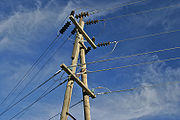
Strain insulator
Encyclopedia

Radio
Radio is the transmission of signals through free space by modulation of electromagnetic waves with frequencies below those of visible light. Electromagnetic radiation travels by means of oscillating electromagnetic fields that pass through the air and the vacuum of space...
antenna
Antenna (radio)
An antenna is an electrical device which converts electric currents into radio waves, and vice versa. It is usually used with a radio transmitter or radio receiver...
s and overhead power lines.
Description and use
A typical strain insulator is a piece of glassGlass
Glass is an amorphous solid material. Glasses are typically brittle and optically transparent.The most familiar type of glass, used for centuries in windows and drinking vessels, is soda-lime glass, composed of about 75% silica plus Na2O, CaO, and several minor additives...
or porcelain
Porcelain
Porcelain is a ceramic material made by heating raw materials, generally including clay in the form of kaolin, in a kiln to temperatures between and...
that is shaped to accommodate two cables or a cable shoe and the supporting hardware on the support structure (hook eye, or eyelet on a steel pole/tower). The shape of the insulator maximizes the distance between the cables while also maximizing the load-bearing transfer capacity of the insulator.

Guy-wire
A guy-wire or guy-rope, also known as simply a guy, is a tensioned cable designed to add stability to structures . One end of the cable is attached to the structure, and the other is anchored to the ground at a distance from the structure's base...
s, overhead power line
Overhead power line
An overhead power line is an electric power transmission line suspended by towers or utility poles. Since most of the insulation is provided by air, overhead power lines are generally the lowest-cost method of transmission for large quantities of electric energy...
s and most other loads, the strain insulator is usually in physical tension
Tension (mechanics)
In physics, tension is the magnitude of the pulling force exerted by a string, cable, chain, or similar object on another object. It is the opposite of compression. As tension is the magnitude of a force, it is measured in newtons and is always measured parallel to the string on which it applies...
.
When the line voltage
Voltage
Voltage, otherwise known as electrical potential difference or electric tension is the difference in electric potential between two points — or the difference in electric potential energy per unit charge between two points...
requires more insulation than a single insulator can supply, strain insulators are used in series: A set of insulators are connected to each other using special hardware. The series can support the same strain as a single insulator, but the series provides a much higher effective insulation.
If one string is insufficient for the weight of a cable(s), a heavy steel plate is used to effectively bundle all the insulator strings together mechanically. One plate is on the "hot" end and another is located at the support structure. This setup is almost universally used on long spans, such as when a power line crosses a river, canyon, lake, or other terrain requiring a longer than nominal span.
Strain insulators are typically used outdoors in overhead wiring. In this environment they are exposed to rain and in urban settings, pollution. As a practical matter, the shape of the insulator becomes critically important, since a wetted path from one cable to the other can create a low-resistance electrical path.
Strain insulators intended for horizontal mounting (often referred to as Dead-Ends) therefore incorporate flanges to shed water, and strain insulators intended for vertical mounting (referred to as Suspension Insulators) are often bell-shaped.

